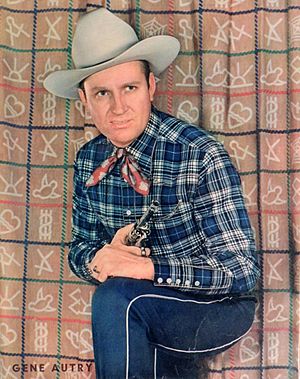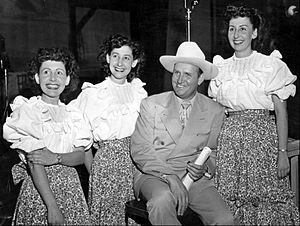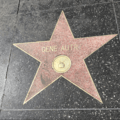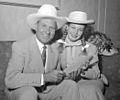Gene Autry facts for kids
Quick facts for kids
Gene Autry
|
|
|---|---|
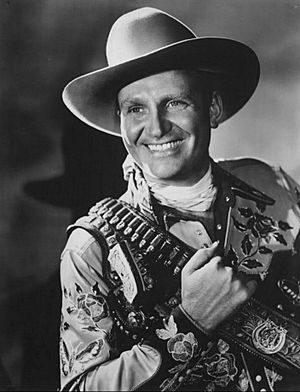
Autry in the 1940s
|
|
| Born |
Orvon Grover Autry
September 29, 1907 Tioga, Texas, U.S.
|
| Died | October 2, 1998 (aged 91) Los Angeles, California, U.S.
|
| Burial place | Forest Lawn, Hollywood Hills Cemetery, U.S. |
| Other names | The Singing Cowboy, Gene Michaels |
| Occupation |
|
| Years active | 1925–1964 |
| Spouse(s) |
|
| Relatives |
|
| Musical career | |
| Genres |
|
| Instruments |
|
| Labels |
|
Gene Autry (born Orvon Grover Autry; September 29, 1907 – October 2, 1998) was a famous American entertainer. He was known as the Singing Cowboy. Gene Autry was an actor, musician, singer, and songwriter. He also performed in rodeos and owned a baseball team.
Autry became very popular on radio, in movies, and on television starting in the 1930s. He starred in 93 films between 1934 and 1953. He also had his own TV show, The Gene Autry Show, from 1950 to 1956. In his movies, he often played a brave and honest hero.
Gene Autry was a very important person in country music. His movies helped bring country music to people all over the country. He is famous for his song "Back in the Saddle Again". Many people also know his Christmas songs, like "Rudolph, the Red-Nosed Reindeer", "Frosty the Snowman", and "Here Comes Santa Claus".
Autry is in the Country Music Hall of Fame. He is the only person to have five stars on the Hollywood Walk of Fame. These stars are for his work in film, television, music, radio, and live performances. A town in Oklahoma, Gene Autry, Oklahoma, is named after him.
Contents
Life and Career Highlights
Early Life and First Jobs
Gene Autry was born on September 29, 1907, in Tioga, Texas. His family later moved to Ravia, Oklahoma. As a boy, Gene worked on his father's ranch. After high school, he became a telegrapher for a railway company. He would sing and play his guitar to pass the time.
Becoming a Singing Star
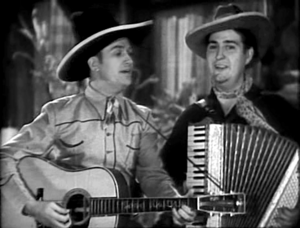
One night, a customer heard Gene singing while he was working as a telegraph operator. This customer was the famous humorist Will Rogers. Rogers told Gene that he should sing professionally. Gene saved money and went to New York to try out for a record company.
In 1929, Gene Autry signed a recording deal with Columbia Records. He worked on a popular radio show called National Barn Dance in Chicago. There, he met songwriter Smiley Burnette, who would become his friend and co-star.
Gene's first big hit song was "That Silver-Haired Daddy of Mine" in 1932. He wrote this song with his friend Jimmy Long. As his movie career grew, so did his record sales. His song "Back in the Saddle Again" became his unofficial theme song.
Gene Autry recorded 640 songs. He wrote or helped write over 300 of them. His records sold more than 100 million copies! He earned many gold and platinum records. He even had the first record ever certified gold.
Today, many people know Gene Autry for his Christmas songs. These songs are played every holiday season. He wrote "Here Comes Santa Claus" after being in a Christmas parade in 1946. He heard people shouting, "Here comes Santa Claus!" and it gave him the idea for the song. He also had huge hits with "Frosty the Snowman" and "Rudolph, the Red-Nosed Reindeer".
Film Career and Cowboy Heroes
In 1934, a film producer named Nat Levine discovered Gene Autry and Smiley Burnette. They first appeared in a movie as part of a singing cowboy group. Soon, Gene got his own starring role in a movie series called The Phantom Empire.
Gene Autry then made 44 more films for Republic Pictures. Most of these were Westerns where he played himself. He rode his horse, Champion, and Smiley Burnette was his funny sidekick. Gene always sang in his movies. His films were very popular. Other movie studios even tried to create their own singing cowboys because of his success.
Gene Autry was one of the biggest movie stars from 1937 to 1942. His films were shown in big cities, not just small local theaters. During World War II, Gene served in the U.S. Air Force. After the war, he returned to making movies.
In 1947, Autry moved to Columbia Pictures. He chose Pat Buttram as his new sidekick. They starred in over 40 films together. In 1951, Gene started his own company, Flying A Productions. This allowed him to have more control over his Western movies.
Melody Ranch Movie Studio
In 1953, Gene Autry bought a large property called Monogram Ranch. He renamed it Melody Ranch, after his movie Melody Ranch. This ranch was used as a filming location for many Western movies and TV shows. Sadly, a wildfire in 1962 destroyed most of the movie sets there. This led Gene to focus on building his Museum of Western Heritage in Los Angeles.
Today, the Melody Ranch is rebuilt and is still used for filming. It also has a museum that is open to the public.
Radio and Television Shows
From 1940 to 1956, Gene Autry had a very popular weekly radio show called Gene Autry's Melody Ranch. His horse, Champion, also had its own radio and TV series!
Gene Autry wanted to teach young people good values. He created the Cowboy Code, or Ten Cowboy Commandments. These rules encouraged an honest, brave, and patriotic way of life. They were very popular with youth groups like the Boy Scouts.
Here are some of the rules from the Cowboy Code:
- The Cowboy must never shoot first or take unfair advantage.
- He must always tell the truth and keep his word.
- He must be kind to children, older people, and animals.
- He must not have unfair ideas about people based on their race or religion.
- He must help people who are in trouble.
- He must be a good worker and keep himself clean.
- He must respect women, parents, and the laws of his country.
- The Cowboy is a patriot.
In 1950, Gene Autry started his own television show, The Gene Autry Show. He produced and starred in it.
Military Service
During World War II, Gene Autry joined the United States Army in 1942. He became a pilot in the United States Army Air Forces. He flew transport planes over the Himalayas between India and China. This dangerous route was nicknamed "the Hump."
Rodeo and Honors
Gene Autry loved rodeos. In 1942, he started his own rodeo stock company. This company provided animals for many major rodeos across the country. He later became the sole owner of the World Championship Rodeo Company.
For his important work in rodeo, Gene Autry was inducted into the ProRodeo Hall of Fame in 1979. He also received other honors for his contributions to Western culture.
Rodeo Honors
- 1972: Hall of Great Western Performers
- 1979: ProRodeo Hall of Fame
- 1980: Hall of Great Westerners
- 1988: Texas Trail of Fame
- 2013: Texas Rodeo Cowboy Hall of Fame
Gene Autry Comics and Toys
Gene Autry was also a popular character in comic books, especially in the 1940s and 1950s. Several comic book series featured him as the hero.
In 1937, a company started making Gene Autry toy cap guns. These toys were very popular, with millions sold around the world.
Baseball Team Owner

In 1960, when Major League Baseball decided to add a team in Los Angeles, Gene Autry became interested. He originally wanted to own the radio broadcast rights for the games. But baseball leaders were so impressed with him that they convinced him to become the owner of the team instead!
The team was first called the Los Angeles Angels. It later moved to Anaheim and became the California Angels. Gene Autry owned the team from 1961 to 1997. He was also the vice president of the American League from 1983 until his death.
The Angels baseball team retired the number 26 in Gene Autry's honor. This number means that he was the "26th man" on the team, always supporting them. When the Angels won their first World Series championship in 2002, the players honored Gene Autry. They played his song "Back in the Saddle Again" and held up his cowboy hat.
Retirement and Legacy
Gene Autry retired from show business in 1964. He had made nearly 100 films and over 600 records. After retiring, he invested in real estate, radio stations, and television stations.
Gene Autry died on October 2, 1998, just after his 91st birthday. He was buried in Los Angeles. His gravestone calls him "America's Favorite Cowboy" and an "American Hero."
The town of Berwyn, Oklahoma, was renamed Gene Autry, Oklahoma in his honor in 1941. Gene had bought a ranch near the town.
Gene Autry's autobiography, written with Mickey Herskowitz, was called Back in the Saddle Again. His Christmas songs, especially "Rudolph the Red-Nosed Reindeer," are still played every year. In 2003, he was ranked among the "40 Greatest Men of Country Music" by CMT.
The interchange of Interstate 5 and California State Route 134 in Los Angeles is named the "Gene Autry Memorial Interchange." There are also streets named after him in Anaheim and Palm Springs, California.
In 2003, Gene Autry was inducted into the National Radio Hall of Fame.
Personal Life
Gene Autry married Ina Mae Spivey in 1932. After she passed away in 1980, he married Jacqueline Ellam in 1981.
Gene Autry was a member of Freemasonry. He was also known for supporting the Civil Rights Movement.
Museum of the American West
The Autry Museum of the American West is in Los Angeles. Gene Autry founded it in 1988. The museum shows much of Gene Autry's personal collection of Western art and items. It also has collections from his friends and other Western film stars.
Discography
Albums
| Year | Album | US Country | Label |
|---|---|---|---|
| 1976 | South of the Border, All American Cowboy | 42 | Republic |
| Cowboy Hall of Fame | 44 |
Singles
1930s
| Year | Single |
|---|---|
| 1932 | "That Silver-Haired Daddy of Mine"+ (w/ Jimmy Long) |
| 1933 | "The Yellow Rose Of Texas" |
| "Cowboy's Heaven" | |
| "The Last Round-Up" | |
| 1935 | "Tumbling Tumbleweeds" |
| 1936 | "You're the Only Star in My Blue Heaven" |
| "Mexicali Rose" | |
| 1938 | "Take Me Back to My Boots and Saddle" |
| "Gold Mine in the Sky" |
1940s
| Year | Single | Chart positions | |||||||
|---|---|---|---|---|---|---|---|---|---|
| US Country | US | ||||||||
| 1939 | "Paradise in the Moonlight" | 1 | — | ||||||
| "South of the Border (Down Mexico Way)"+ | 1 | 15 | |||||||
| "Back in the Saddle Again"+ | 1 | — | |||||||
| "Little Sir Echo" | 1 | — | |||||||
| "A Gold Mine In Your Heart" | 13 | — | |||||||
| "Blue Montana Skies" | 16 | — | |||||||
| 1940 | "I'm Beginning To Care" | 1 | — | ||||||
| "The Merry-Go-Roundup" | 2 | — | |||||||
| "Goodbye Little Darlin' Goodbye" | 1 | 20 | |||||||
| "Mary Dear" | 4 | — | |||||||
| "Were You Sincere" | 1 | — | |||||||
| "Broomstick Buckaroo" | 3 | — | |||||||
| "Blueberry Hill" | 6 | — | |||||||
| "When I'm Gone You'll Soon Forget" | 6 | — | |||||||
| "El Rancho Grande" | 11 | — | |||||||
| "Singing Hills" | 11 | — | |||||||
| 1941 | "You Are My Sunshine"+ | 1 | 23 | ||||||
| "Be Honest With Me" | 1 | 23 | |||||||
| "You Waited Too Long" | 2 | — | |||||||
| "It Makes No Difference Now" | 6 | — | |||||||
| "Lonely River" | 9 | — | |||||||
| 1942 | "Tweedle-O-Twill" | 1 | — | ||||||
| "Deep in the Heart of Texas" | 1 | — | |||||||
| 1943 | "It Makes No Difference Now" | 3 | — | ||||||
| "I Hang My Head and Cry" | 4 | — | |||||||
| "We've Come A Long Way Together" | 10 | — | |||||||
| 1944 | "I'm Thinking Tonight of My Blue Eyes" | 3 | — | ||||||
| 1945 | "At Mail Call Today" | 1 | — | ||||||
| "I'll Be Back" | 7 | — | |||||||
| "Gonna Build a Big Fence Around Texas" | 2 | — | |||||||
| "Don't Fence Me In" | 4 | — | |||||||
| "Don't Hang Around Me Anymore" | 4 | — | |||||||
| "Don't Live a Lie" | 4 | — | |||||||
| "I Want to Be Sure" | 4 | — | |||||||
| 1946 | "Silver Spurs (On the Golden Stairs)" | 4 | — | ||||||
| "I Wish I Had Never Met Sunshine" | 3 | — | |||||||
| "You Only Want Me When You're Lonely" | 7 | — | |||||||
| "Wave to Me, My Lady" | 4 | — | |||||||
| "Have I Told You Lately that I Love You?" | 3 | — | |||||||
| "Someday (You'll Want Me to Want You)" | 4 | — | |||||||
| 1947 | "Home On The Range"/"Red River Valley" | — | — | ||||||
| "You're Not My Darlin' Anymore" | 3 | — | |||||||
| 1948 | "Here Comes Santa Claus (Down Santa Claus Lane)"+' </ref> | 5 | 8 | ||||||
| "Buttons and Bows" | 6 | 17 | |||||||
| "Here Comes Santa Claus (Right Down Santa Claus Lane)" | 4 | 8 | |||||||
| 1949 | "Ghost Riders in the Sky" | — | — | ||||||
| "Rudolph, the Red-Nosed Reindeer"+ (w/ The Pinafores) | 1 | 1 | |||||||
| "Here Comes Santa Claus (Right Down Santa Claus Lane)" | 8 | 24 | |||||||
| "—" denotes releases that did not chart | |||||||||
1950s
| Year | Single | Chart positions | |||||||
|---|---|---|---|---|---|---|---|---|---|
| US Country | US | ||||||||
| 1950 | "Peter Cottontail"+ | 3 | 5 | ||||||
| "Frosty the Snow Man"+ (w/ The Cass County Boys) | 4 | 7 | |||||||
| "Rudolph, the Red-Nosed Reindeer" (w/ The Pinafores) | 5 | 3 | |||||||
| 1951 | "Old Soldiers Never Die" | 9 | — | ||||||
| 1952 | "Up on the Housetop" | — | — | ||||||
| 1957 | "Nobody's Darlin' but Mine" | — | — | ||||||
| "Rudolph, the Red-Nosed Reindeer" (re-entry) | — | 70 | |||||||
| "—" denotes releases that did not chart | |||||||||
1990s
| Year | Single | Chart positions | |||||||
|---|---|---|---|---|---|---|---|---|---|
| US Country | US AC | ||||||||
| 1998 | "Rudolph, the Red-Nosed Reindeer" (re-entry) | 55 | — | ||||||
| 1999 | "Rudolph, the Red-Nosed Reindeer" (re-entry) | 60 | 24 | ||||||
| "—" denotes releases that did not chart | |||||||||
2010s
| Year | Single | Chart positions |
|---|---|---|
| US | ||
| 2018 | "Rudolph, the Red-Nosed Reindeer" (re-entry) | 16 |
| "Here Comes Santa Claus (Down Santa Claus Lane)" (re-entry) | 28 | |
| 2019 | "Rudolph, the Red-Nosed Reindeer" (re-entry) | 22 |
| "Here Comes Santa Claus (Down Santa Claus Lane)" (re-entry) | 32 |
2020s
| Year | Single | Chart positions |
|---|---|---|
| US | ||
| 2020 | "Rudolph, the Red-Nosed Reindeer" (re-entry) | 16 |
| "Here Comes Santa Claus (Down Santa Claus Lane)" (re-entry) | 26 | |
| 2021 | "Rudolph, the Red-Nosed Reindeer" (re-entry) | 19 |
| 2022 | "Rudolph, the Red-Nosed Reindeer" (re-entry) | 28 |
| "Here Comes Santa Claus (Down Santa Claus Lane)" (re-entry) | 25 |
Holiday 100 Chart Entries
Many of Gene Autry's holiday songs appear on the Holiday 100 chart each December. This chart tracks the most popular holiday songs using streaming, radio play, and sales data.
| Title | Holiday season peak chart positions | |||||||||||
|---|---|---|---|---|---|---|---|---|---|---|---|---|
| 2011 | 2012 | 2013 | 2014 | 2015 | 2016 | 2017 | 2018 | 2019 | 2020 | 2021 | 2022 | |
| "Rudolph the Red-Nosed Reindeer" | 14 | 14 | 11 | 11 | 8 | 10 | 10 | 7 | 10 | 14 | 13 | 17 |
| "Here Comes Santa Claus (Down Santa Claus Lane)" | 45 | 34 | 43 | 48 | 27 | 37 | 18 | 10 | 12 | 12 | 25 | 19 |
| "Up on the Housetop (Ho! Ho! Ho!)" | — | — | 80 | — | — | 94 | 80 | 72 | 94 | 91 | 74 | 84 |
| "Frosty the Snowman" | — | — | — | — | 100 | 90 | — | — | — | — | — | — |
Filmography
Gene Autry starred in 93 films from 1934 to 1953. He also appeared in 91 episodes of The Gene Autry Show TV series from 1950 to 1955. Many of these films and TV episodes have been restored and are still available to watch today.
|
|
Images for kids
See also
 In Spanish: Gene Autry para niños
In Spanish: Gene Autry para niños
- Autry Museum of the American West
- Melody Movie Ranch
- Hollywood Christmas Parade
- Gene Autry, Oklahoma
- List of best-selling music artists
- List of Freemasons


